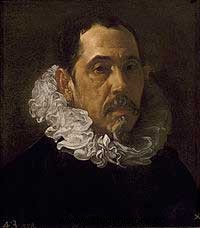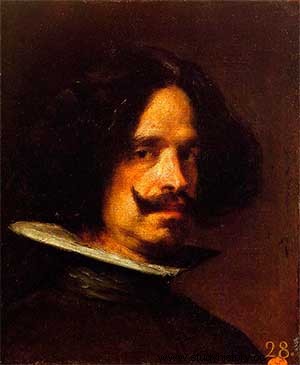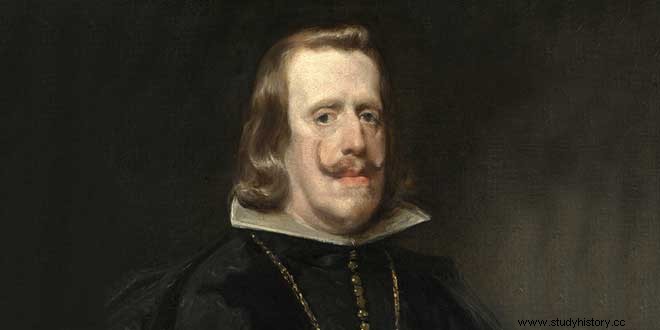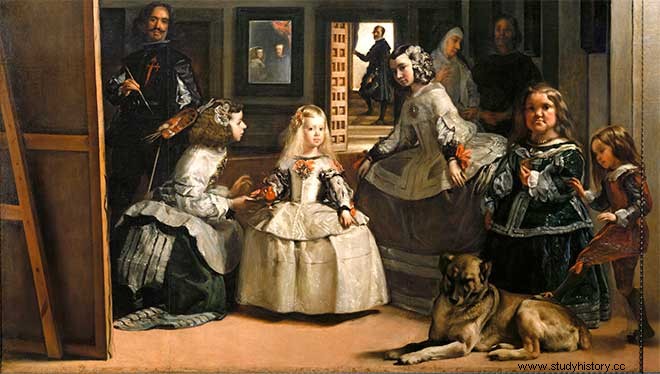Diego Rodríguez de Silva y Velázquez was born in 1599, on Sunday June 6, 1599 he was baptized , by the lawyer Gregorio de Salazar — priest of the church of San Pedro, Seville — a boy, born in the same city eight or nine days before, whom he named Diego. The boy was the son of Juan Rodrigues de Silva, of Lusitanian descent, and Doña Jerónima Velázquez, of a noble family. He acted as compadre Pablo Ojeda, a neighbor of the Magdalena neighborhood, who was routinely warned of the spiritual kinship he acquired. Pablo Ojeda on that occasion threw the house out the window, inviting cakes from San Juan de Alfarache and clear wine from the Dos Hermanas candiotas. And he paid four peals of bells to a cunning sacristan and bawls — alluding to the godfather's long health — to a few dozen dirty and ragged children, throwing poor coins at them in the scramble.
Education

With an admirable love of drawing, which amazed relatives and strangers, Diego was sent to the workshop of the ill-tempered and bilious Francisco de Herrera , very fond of distributing capons and tremendous smacks among his apprentices. To avoid the first of which, the serious boy Dieguito asked his parents to take him to another workshop. Which was that of Don Francisco Pacheco, whom Velázquez had already attended in 1610. Pacheco was not a great painter, but he was an extraordinary teacher and a great person, and he soon guessed the formidable talent of his new disciple, whom he taught how much he knew , but without forcing his tastes or his qualities. In 1617, after some exercises carried out before Pacheco and another painter named Juan de Uceda, Velázquez received the title of «maestro» . A year later he married Juana Pacheco, daughter of her teacher, a woman who is neither beautiful nor excessively intelligent, but full of self-sacrifice and love for her husband . As, after a few years, Pacheco was told that he would be very proud to be the father-in-law of that genius, he replied with simple pride «that he was more honored to have been his teacher» . But let's read what Pacheco wrote about such events: «After five years of education and teaching I married him to my daughter, moved by her virtue, cleanliness and good parts of her, and by the hopes of the natural and great wit of her. And because the honor of a teacher is greater than that of a father-in-law, it has been fair to hinder the audacity of someone who wants to attribute this glory, taking away the crown of my last years. I do not consider it a decrease if the disciple outstripped the master - having told the truth that he is not greater -, nor did Leonardo da Vinci lose in having Raphael as a disciple, nor Jorge de Castellfranco to Titian, nor Plato to Aristotle, since he did not take away his name. of divine» .
Arrival at the king's court
Some delightful works have survived from those early years of Velázquez's apprenticeship:An Old Woman Frying Eggs, Grape Harvester, Sevillian Water Bearer, and religious compositions submitting to the pious and silly sweetness of the time:the Virgin handing over the chasuble to Saint Ildefonso, Adoration of the Kings, a Conception… But the artist Velázquez “drowns” in the Sevillian atmosphere. Pacheco fully realizes this and encourages him to move to Madrid. So does the painter; but in this first stay in the Villa and Court he did not achieve anything that he wanted. In 1622 he is back in Seville. A year later he is again in the capital of Spain. He brings good letters of recommendation for a Sevillian Guzmán, Don Gaspar, Count-Duke of Olivares, absolute owner of the will of the new king, Felipe IV, who is, in addition to being a nice crowned botarate, a very good fan of the arts. Olivares gets a great opportunity for his fellow artist:for him to paint a portrait of the king. And he is so amazed by the work that he immediately appoints him as his «exclusively» portraitist. . This designation forces him to live in the Royal Palace and to portray all the people who surround the monarch daily:queen, princes, Olivares, nobles... From these first years of his official and palatial position are his portraits of Olivares —in the Hispanic Society of New York, and the best ever done to the minister and almighty valet —; that of the Infante don Carlos, brother of Philip IV; the first equestrian portrait of Felipe IV, which stunned everyone who saw it and which burned in the Alcázar fire in 1734.
Velazquez in Italy

Important year for Velázquez was 1627. Felipe IV wanted to endure a decision of his good father Don Felipe III:the expulsion of the Moriscos . And he opened a contest in which Velázquez, Carducho, Caxés and Nardi competed. Naturally, the winner was Velázquez, and even though the enmity of the vanquished was attracted, he was named Chamber Usher and given a large room in the Alcázar so that he could convert it into a workshop. The first exercises carried out in this workshop were, probably, The Geographer, from the Rouen Museum, The Calabacillas, from the Cook Collection, The Drunkards, his first large painting with a mythological theme . Another stupendous opportunity for the artist in the year 1628. Rubens, the famous Flemish master, arrives in Madrid for the second time on a diplomatic mission entrusted to him by the Regent Archdukes Isabel Clara — the beloved daughter of Don Felipe II — and Alberto. And it is Rubens — who has previously collaborated on some drawings with Velázquez — who encourages him to move to Italy, adding that this delayed trip is essential for him to complete and refine his art. Diego insistently begs to be allowed to go to Italy, and he succeeds on June 26, 1629 . He embarks in Barcelona and disembarks in Genoa. In Italy he visits Verona, Venice, Ferrara, Bologna, Loreto, Rome and Naples. He hardly paints during this pilgrimage that has his eyes open and his understanding as if by magic. However, according to modern criticism, during this trip Velázquez painted some portraits and two large paintings:José's tunic, from El Escorial, and Vulcano's forge, from Prado .
Return of Velazquez to court
But Diego de Velazquez is urgently requested by the king and by his favourite, Diego de Velazquez is forced to give up his dreams, to return to Spain, to lock himself in the Alcázar to start a constant, refined, restless work . Because his position as chamber painter is going to require a greater effort. And to prepare for the great task he begins by painting three of his famous religious paintings:Christ after the scourging, from the National Gallery, London; the Crucified Christ, for the nuns of the Madrid convent of San Placido, and Saint Thomas Aquinas comforted by angels, from the Orihuela cathedral . Velázquez's great task begins with the commission for the pictorial decoration of the Hall of Kingdoms in the Palacio del Buen Retiro, just inaugurated, as an apotheosis that the Count-Duke of Olivares offers to his king. For this Salon Velázquez painted The Surrender of Breda, the beautiful equestrian portraits of Felipe IV and the charming little prince Baltasar Carlos against the marvelous backgrounds —bluish and melancholy— of the snowy Guadarrama. La Maliciosa in the second of the portraits. With such important commissions, the brilliant artist mixed with many others:more portraits of Felipe IV; the portrait of the crossbowman of King Juan Mateos; the portraits of the Ipeñarrieta family; the prodigious portrait of Pablillos de Valladolid; the Count-Duke, of the Hermitage; Prince Baltasar Carlos, of Vienna; Saint Anthony and Saint Paul, hermits. The painter accompanied his monarch in the so-called Aragon campaign —1644—, and during it he made one of the best portraits of the monarch:the one with the flare in his hand, a marvelous symphony in reds and silver, preserved in the Frick Collection, from New York. Once again locked up in the Alcázar of Madrid, he multiplies his works:the Count-Duke of Benavente, Cardinal Borja, The Lady with a Fan; the impressive and very humane paintings with the portraits of the madmen and buffoons of the king's court:Don Sebastián de Morra, el Primo, el Niño de Vallecas, El Bobo de Coria; Aesop and Menippus , portentous figures whose miserable and touching humanity is humorously —which means:melancholy— semi-covered by the symbolism of a classical typology.

Velázquez the favorite of the court
In 1634 Velázquez's only daughter who lived with him married his favorite disciple Juan Bautista del Mazo. Brainy marriage and calm family affections. She was dark and very honest. He, slow and severe, shy and unconditional adorer of the teacher and her father-in-law. In Mazo, Velázquez renounced his office as Chamber Usher, authorized by Felipe IV. In 1642 he accompanied the brilliant painter to the monarch when he went to Catalonia to suppress an uprising. The two from Zaragoza do not pass. The Count-Duke wanted Felipe IV not to attend the campaign and to entertain himself watching ball play, and strolling through the city of the Ebro, twice a day, with his entourage of twelve baroque cars and four hundred marching and uniformed soldiers « of postin». Meanwhile, Velázquez and Mazo painted the delicious View of Zaragoza. Nothing affected Velázquez by the resounding fall of the favorite Count-Duke of Olivares, who had to retire to Loeches —1643—, because although it was Olivares who introduced him to the Palace, Velázquez was not only much loved, but also indispensable for the monarch, his relatives, the nobles . They all sincerely loved him. The seductive personality of the artist, his dignity and his nobility had been imposed on all social media, and he was in truth not a palatine servant, but a "plain" palatine. Ortega y Gasset writes:«Velázquez is a gentleman who from time to time gives a few brushstrokes... Phlegmatic, taciturn, thoughtful and kindly temperament, a man without gall and without vanity who slowly elaborated his paintings and, demanding a lot from himself , amended and corrected them, letting life pass with the serene aplomb of someone who is in no hurry or ambition, knowing around the court a complicated and picturesque world from which he knew how to extract, as if from an incomparable quarry, the lights of humanity that reflect the characters on his canvases» .
Trip in search of works
New trips in 1644. The jobs that he performs in the palace impose such wanderings on the painter. The French had besieged Lerida. Felipe IV, dressed as a soldier, dressed as a yellow and red soldier, playing the guts, took part in the battle given to raise the fence from places of some exhibition and taking care of the corvettes of his roan horse and the air of the feathers of his hat. And even, holding the reins with his left hand, he extended his right arm, his hand and his index finger to point out where he was to attack. Very imperious and decorative attitude that always surprised him in almost all the great captains immortalized by brushes. Felipe IV triumphantly entered Lérida. And if we are to believe an excellent critic:“in a suede suit, embroidered with silver and gold, a red band embroidered in gold and a white mother-of-pearl hat” . With such an attire, already prepared for the apotheosis, days before the triumph, and when he still did not know if he would triumph, yes:triumphant his desire, in Fraga and in a studio set up inside a mansion with a heraldic portal and coming to less, in little Velázquez portrayed him for more than three days to send Madrid a testimony of the heroism of the poet-king.
Second trip to Italy
Until 1634 he was Velázquez Usher. Until 1643, Cloakroom Assistant. He was assistant to the Chamber until 1648. In this year he was appointed overseer of the works that were carried out in the old tower of the Alcázar to manufacture a large octagonal piece. In his Discursos practicables, Jusepe Martínez recounts the following:«His Majesty proposed to Velázquez that he wanted to make a gallery of paintings, and for this he should look for master painters to choose the best among them, to which he replied:“ Your Majesty must not have pictures that every man can have”. He replied his Majesty:“How is this to be?” Velázquez responded:“I dare, sir, if Your Majesty gives me permission, to go to Rome and Venice to look for and celebrate the best paintings that are found by Titian, Pablo Veronese, Basán, Rafael de Urbino, Palmesano and others. similar, that of these such paintings there are few princes who have them, and in as much quantity as Your Majesty will have with the diligence that I will do; and more than that it will be necessary to adorn the lower rooms with ancient statues, and those that cannot be found will be emptied and the females will be brought to Spain to be emptied here later with all due respect”» . And Felipe IV gave him permission to return to Italy with all the comforts and credit. Velázquez left Madrid on November 16, and Malaga on January 21, 1649. The journey was not a happy one. The brilliant painter was accompanied by his loyal servant and notable painter Juan de Pareja, whom he painted, "to make brushes" , in one of his best works.
Portrait of Inocencio X
He visited Milan, Padua, Bologna, Florence, Modena, Parma, Rome, Naples. And even when his was a business trip, he had no choice but to paint many portraits, several of which have been lost, including that of Olimpia Maidalchini, intriguing and powerful sister-in-law of Pope Innocent X. Naturally, the most famous painting that Velázquez painted in Rome was that of Pope Juan Bautista Pamphili, and that is one of the most extraordinary portraits of universal painting , and, according to the great English painter Reynolds “the most beautiful canvas that Rome keeps” . Innocent X and the Vatican court were stunned. He gave the artist a thick gold chain from which hung an enormous medal of the same metal with the papal effigy. Immediately the brilliant artist had to agree to paint other portraits. The aforementioned Olimpia Maidalchini, the painter Flaminia Triumphi, Cardinal Pamphili, Fernando Brandano, Camilo Máximo, Jerónimo Vibaldo, Abad Hipólito, Micaelo Angeli.

Call from King Felipe IV
Velázquez remained in Italy for two and a half years. In it he had to find himself "like a fish in its element":triumphant, entertained, in an environment without sanctimoniousness and conducive to the most surprising freedoms . How many letters did Philip IV send you, by very different messengers and all of them “very luxurious”, asking you to return urgently? It is precisely in such letters that the assertion that Velázquez was just one more servant of the sovereign, a somewhat distinguished servant in the palace, is refuted. They are letters not from a despotic king to his servant, but from an indulgent friendly king who admires and needs his painter. Felipe IV writes to the Duke of the Infantado: «… that you give me an account of what Velázquez was doing… and since you know his phlegm, it is good that you try not to exercise it…; I send to order the Count of Oñate to assist him with the money that he has failed to send him, according to what he needs, because he has no pretext or excuse to postpone the trip…; that he does not do it by land (the trip), so that he could entertain himself, and more with his natural… » . When he had her by his side, not the slightest recrimination. Just congratulations and hugs.
Velázquez painting evolution
On his return from Italy, the pressures of new portraits of Don Felipe, of his second wife, Doña Mariana de Austria, of the recently born Infanta Margarita, awaited him. By the way, as a result of this birthday, there were great celebrations in Madrid, and Velázquez received 33,337 reales that were owed to him. He was also appointed Housekeeper of the Palace, a position that, according to the graceful himself, suited him "so adjusted to his genius and occupation" . Undoubted proof of the great affection that the king had for him, since as such a roomer he would accompany him on all the trips he made, preparing his days and his lodgings.
Despite the fact that the palatine obligations multiplied, Velázquez took long time out of short time to paint more. And as the critic Lafuente Ferrari affirms: «His painting of him becomes more and more fluid, less plastic; all precision of lines is lost in the forms, which are represented as a function of light, of concrete and determined light, seen in a certain space and at a certain moment; Capturing light and translating it into pure stain and color values is now his main object, and it is this light, mistress of forms, that Velázquez, with a loose, sensitive brushstroke, unaware of the lines, saves on the canvas… Brushwork and values, like vehicles of light, can carry in themselves, in the brilliant synthesis of Velázquez, everything that had constituted until now the scholastic framework that served as a support for the art of painting:drawing, line, arabesque, perspective linear, geometric translation of space and form. Everything has been eliminated, synthesized embedded in the slight lump of semi-liquid color that Velázquez puts in his touch on the canvas. This is the brilliant operation with which the brilliant Sevillian painter reaches a goal not surpassed in the process of Western painting, as is unanimously recognized today» . This miracle achieved by Velazquez painting is already evident in the delicious and amazing landscapes of the Villa Médicis, painted in Rome, and which are a perfect and seductive, unforgettable summary of romantic melancholy and impressionist vision. The light, the air, the fluid brushstroke substituting with advantage the precision of the drawing, since the impression of the whole is sought, and not of each one of the parts.
CreationofthegreatworksofVelázquez
In these years, Velázquez painted several portraits of the Infanta María Teresa, since Don Felipe lacking a male heir, it was convenient for the infanta to make a good diplomatic marriage, for which her portrait had to be sent to the courts of Europe, in search of a single prince. . The infanta was beautiful and sweet, qualities inherited not from the Austrias, but from her beautiful and gentle mother, Doña Isabel de Borbón. He also had to portray the new queen, Doña Mariana, and the children of this new royal marriage:Prince Felipe Próspero, Infanta Margarita —full of grace/blonde and dark eyes—, always painted wrapped in silver and roses... But there are three incomparable, portentous paintings by Velázquez, in these last years of his life:The Venus of the mirror, Las Meninas and Las hilanderas .
The venus in the mirror
The Venus is one of the very few nudes in classical Spanish painting. It is said that he was modeled after a beautiful and scandalous actress named Damiana, long beloved by the madcap Marquis of Heliche. Located today in the National Gallery in London.
The spinners
Atmosphere and colour. These are the main charms of Las hilanderas, a scene taken by Velázquez in the Tapestry Factory on Santa Isabel Street in Madrid. Ortega y Gasset was the one who first affirmed the mythology of this painting:the fable of Pallas and Arachne, relegated to the background of the tapestry, and also, in the foreground, the weavers who symbolize the Fates, spinners of each of our lives.
Las meninas
And perhaps the only one that completely exceeds it is Las Meninas. A rosary of fifteen tens of canonical praises to be prayed out loud and out loud. What was the suggestive idea of this painting? Velázquez is portraying — once again among many times — the monarchs. Suddenly, like a whirlwind of blonde graces, the infantina Margarita, the artist's little right eye, enters the room, followed by her meninas, her dwarfs, her Molossian dog . Margaret is silent. She looks at her parents, firm and mated with less solemnity than ever and an unassuming intimacy of home. She looks at the canvas, which is being painted with pleasant familiarity, far removed from engrossment, from rehearsed reverence. As if at dim light, she, as if in a whisper, she is in the big room with the rancid mansion. Such a charming moment was well worth lasting, oblivious to the mandatory, because he had already taken good care to exempt himself from rhetoric. And it was lasting. Perhaps by the will of kings. Perhaps due to the delicate interest of the artist himself . Velázquez paints the monarchs, whom we see because they are vaguely reflected in the mirror. Through the back door — with panels, open — which leads to a better lit room, a palatine leaves, but he has stopped and looks back. In the foreground, the Infanta Margarita, between her meninas, Doña María Agustina Sarmiento and Doña Isabel de Velasco. On the right, the dwarf Maribárbola, the mastiff lying down, meek, who doesn't seem to give importance to the kick that Nicolasillo Pertusato hits him, a funny dwarf, richly dressed, who looks like a toy. On the left, a large canvas upside down leaning on the easel. And before the canvas, Velázquez, with the brush in his right hand and the palette in his left, seems to be looking at the kings... who are precisely where we are looking at the painting.

Death of Velázquez
In 1659 it was a bad year for Spain. The so-called Peace of the Pyrenees is adjusted between her and France. On October 16, the marshal Duke of Agramont, extraordinary ambassador of Louis XIV, entered Madrid. He even asked the French monarch for the hand of the most serene Infanta Maria Teresa of Austria. Then Velázquez, as His Majesty's lodger, had to accompany the French ambassador on his visits to Buen Retiro, El Pardo, El Escorial, the stately homes of Oñate, Haro, Lerma, Medina de las Torres, Gaviría... When the French left, he left Velázquez, as a gift, a gold watch with diamonds.
In 1660 in the month of March, Velázquez, royal lodger, who had to precede the monarchs on their trips, preparing lodging for them, had to leave Madrid heading north . Philip IV was preparing to set out for Irun to hand over his daughter, the Infanta Maria Teresa, the future wife of Louis XIV, to the French border. Don Diego Velázquez, forgetting about his brushes, marched under his command José de Villarreal, assistant furriera and senior master of the Royal Works. The royal accommodation was prepared in Alcalá de Henares, Guadalajara, Valladolid, Burgos, Vitoria, San Sebastián and Fuenterrabía. The return took place on June 8. Velázquez arrived in Madrid feeling bad:dizziness, tremendous palpitations, heartburn . He had to stay in bed. The king sent his family doctor. On Friday, August 6, 1660, Velázquez died , after having devoutly received the Holy Sacraments. He was buried in the Parish of San Juan Bautista.
